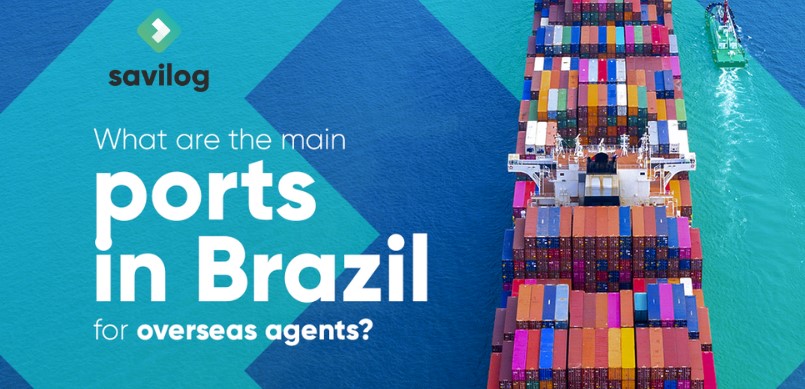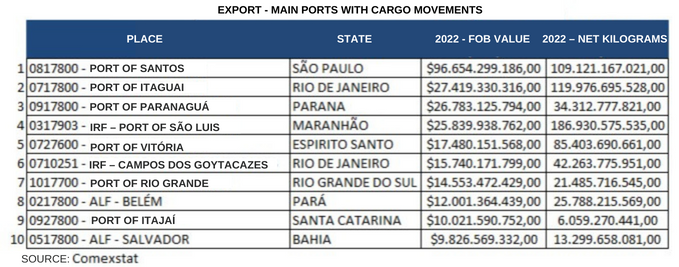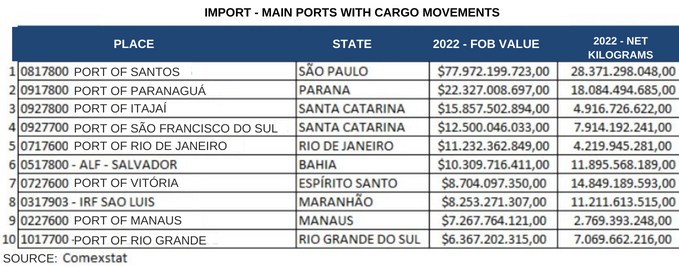
What are the main ports in Brazil for overseas agents?
It was January 28, 1808 – the milestone of the royal family arrival in Brazil – when Prince D. João signed the decree that opened the ports. Such decree settled the beginning of the affairs with friendly nations, making it possible for the Brazilian market to start receiving English goods, thus breaking the colonial pact.
This is how Brazil began its connections with the world, the links of global scope that carry out the movement, transshipment, and cargo storage to supply, not only Brazilian, but global needs. In the year of 2023, we are seeing record-breaking annual cargo movements along the Brazilian ports, but what ports are we talking about? We’ll find out more about them in the text below!
What are the major ports in Brazil?
Brazil has around 175 cargo port facilities throughout the extensive national territory, which includes river and lake structures, such as terminals, ports and waterway facilities. Out of all these installations, 76 are located off the coastline, 52 of them are in the north, 6 in the mid-west and 18 of them are in the southern region of Brazil.
The seven largest Brazilian ports are presented below, although they’re not necessarily the ones that handle the most cargo movement:
- Port of Santos, in São Paulo: located on the Atlantic coast, it is the largest port in Brazil. It accounts for more than 70% of the national cargo volume;
- Paranaguá Port: located in Paraná, it is Brazil’s second largest port;
- Port of Itajaí: located on the coast of Santa Catarina, it is the third largest port in Brazil;
- Port of Rio Grande: Located in Rio Grande do Sul, it is considered the fourth largest port in Brazil;
- Port of Suape: located on the coast of Pernambuco, it is the fifth largest port in Brazil;
- Port of Vitória, in the State of Espírito Santo: it is the sixth largest port in Brazil;
- Port of Manaus, in Manaus: located in the State of the Amazonas region, it is the seventh largest port in Brazil.
The major ports in Brazil and their main figures
The models of ports currently represented in Brazil are formed by six different systems:
- Organized Ports: These are ports managed by public agents and belong to the Federal Government. They go through a bidding process, when facilities are leased to be operated by private port operators;
- Private Terminal of Exclusive Use (TUP-E in Portuguese): They are private terminals built only to handle the terminal owner’s cargo. They get permission by a formalized adhesion contract, without any bidding or fees payments;
- Private Terminals of Mixed Use (TUP-M in Portuguese): They are also private terminals built to handle the terminal owner’s cargo, with third parties’ cargos subsidiary, by means of authorization according to the current legislation;
- Small Public Port Facilities (IP4 in Portuguese): These are facilities used to berth regional vessels that transport people and goods;
- Cargo Transshipments Stations (ETC in Portuguese): According to ANTAQ Resolution 2520, it is a “port facility located outside the organized port area, exclusively used for cargo transshipments operations destined to or coming from inland navigation“;
- Private Tourism Terminals (IPTur in Portuguese): These are terminals for the disembarking and transit of crew members, luggage, passengers, and also for the supply of tourism-oriented vessels. Such terminals can only function by means of authorization.
As you can see, each one of models above has its specific characteristics and forms of operation throughout the Brazilian market.
The main Brazilian ports in terms of cargo volume
When observing the cargo volume movement, the Port of Santos is first in relation to imports and exports. In 2022, the port of Santos set a historical record of cargo movement, being 10.5% above 2021. Furthermore, in terms of containers’ volume, it reached 5 million TEU (1 TEU = 1 20-foot container) in 2022. Since its maximum capacity is 5.3 million TEUs per year, it was pretty close to reach its full capacity. Regarding the flow of ships, over the last 12 months, it totaled 5202 attractions, so it also increased up to 7.1% compared to 2021.
Let’s get to other figures, then!
Export
In exports, as mentioned above, the Port of Santos is first, as in 2022 more than US$96 billion dollars and more than 109 billion net kilograms were handled.
The Port of Itaguaí, in Rio de Janeiro, took the second place, and third is the Port of Paranaguá, in Paraná. The Port of Rio Grande, appears in seventh place among the main ports with cargo movements in the year of 2022.

Imports
About imports, we do not observe a very different scenario, with Santos being first, after handling more than US$77 billion in 2022. Paranaguá rises to second place, since it handled US$22 billion, followed by the port of Itajaí, in Santa Catarina, with a considerable movement for 2022.

The Port of Rio Grande appears only in tenth place concerning the imports category, although it still has a significant participation for the state of Rio Grande do Sul.
Did you like the reading? Then like it, comment it and share it!